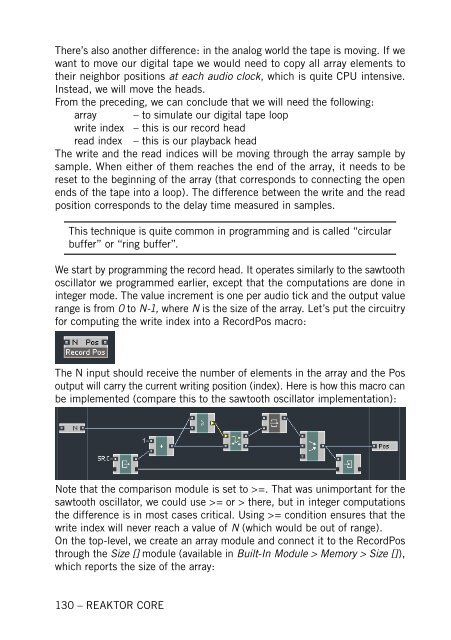1. First steps in Reaktor Core - Native Instruments
1. First steps in Reaktor Core - Native Instruments
1. First steps in Reaktor Core - Native Instruments
You also want an ePaper? Increase the reach of your titles
YUMPU automatically turns print PDFs into web optimized ePapers that Google loves.
There’s also another difference: <strong>in</strong> the analog world the tape is mov<strong>in</strong>g. If we<br />
want to move our digital tape we would need to copy all array elements to<br />
their neighbor positions at each audio clock, which is quite CPU <strong>in</strong>tensive.<br />
Instead, we will move the heads.<br />
From the preced<strong>in</strong>g, we can conclude that we will need the follow<strong>in</strong>g:<br />
array – to simulate our digital tape loop<br />
write <strong>in</strong>dex – this is our record head<br />
read <strong>in</strong>dex – this is our playback head<br />
The write and the read <strong>in</strong>dices will be mov<strong>in</strong>g through the array sample by<br />
sample. When either of them reaches the end of the array, it needs to be<br />
reset to the beg<strong>in</strong>n<strong>in</strong>g of the array (that corresponds to connect<strong>in</strong>g the open<br />
ends of the tape <strong>in</strong>to a loop). The difference between the write and the read<br />
position corresponds to the delay time measured <strong>in</strong> samples.<br />
This technique is quite common <strong>in</strong> programm<strong>in</strong>g and is called “circular<br />
buffer” or “r<strong>in</strong>g buffer”.<br />
We start by programm<strong>in</strong>g the record head. It operates similarly to the sawtooth<br />
oscillator we programmed earlier, except that the computations are done <strong>in</strong><br />
<strong>in</strong>teger mode. The value <strong>in</strong>crement is one per audio tick and the output value<br />
range is from 0 to N-1, where N is the size of the array. Let’s put the circuitry<br />
for comput<strong>in</strong>g the write <strong>in</strong>dex <strong>in</strong>to a RecordPos macro:<br />
The N <strong>in</strong>put should receive the number of elements <strong>in</strong> the array and the Pos<br />
output will carry the current writ<strong>in</strong>g position (<strong>in</strong>dex). Here is how this macro can<br />
be implemented (compare this to the sawtooth oscillator implementation):<br />
Note that the comparison module is set to >=. That was unimportant for the<br />
sawtooth oscillator, we could use >= or > there, but <strong>in</strong> <strong>in</strong>teger computations<br />
the difference is <strong>in</strong> most cases critical. Us<strong>in</strong>g >= condition ensures that the<br />
write <strong>in</strong>dex will never reach a value of N (which would be out of range).<br />
On the top-level, we create an array module and connect it to the RecordPos<br />
through the Size [] module (available <strong>in</strong> Built-In Module > Memory > Size []),<br />
which reports the size of the array:<br />
130 – REAKTOR CORE










